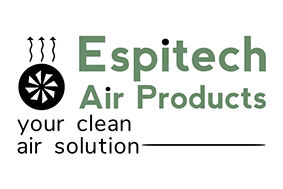Reviewing UV Air Purification
| Applications | Why Allerair | Air Purifier Models - Series | Filtration Guarantee |
In the world of air purification, ultraviolet germicidal irradiation (or UV) is just one of many possible filters to consider -usually recommended as an add-on to other filters, not as a stand-alone option.
How Does UV work?
The electromagnetic radiation of UV light works with wavelengths that are shorter than visible light to disrupt bacteria, viruses and other micro organisms.
The UV lamps designed to kill germs in portable air purifiers typically consist of low pressure mercury vapor lamps with a UV radiation wavelength of 263.7 nanometers. At this wavelength, biological contaminants cannot survive prolonged exposure to UV light. At the right exposure, the ultraviolet rays penetrate a cell’s outer structure and alter its DNA, causing cell death. The air must be moving past the lamp so that the UV can work. Sometimes, multiple passes of air may be required.
UV is not effective for some bacterial and mold spores that have become resistant. It doesn’t promise to trap airborne particles like a HEPA filter or to remove airborne chemicals by way of adsorption like an activated carbon filter. A UV filter is designed to neutralize biological organisms passing through the ultraviolet rays by altering the DNA of bacteria, viruses and mold spores and inhibit reproduction.
Brief History of Ultraviolet Germicidal Irradiation
More than 100 years ago, in 1878, two scientists published a paper about the short-wavelength light and its ability to sterilize bacteria. People soon realized the potential of UV light for sterilization and in 1903, they discovered that a wavelength of 250-260 nanometers was the most effective for that purpose. Niels Finsen won the 1903 Nobel Peace Prize when he used UV to treat a skin condition called lupus vulgaris.
How UV is Used Today
Ultraviolet germicidal irradiation has been used since the mid twentieth century as a disinfection method in the food industry, medical field and other sciences. In the field of water purification, UV helps to sterilize drinking water and wastewater. In all of these applications, UV is typically used in the form of germicidal lamps in sealed-off rooms, water tanks and forced air systems to expose microorganisms to the electromagnetic radiation.
Some air purifiers can accommodate a UV light to sterilize the air as it passes through the unit. Other UV lamps purify the air when installed into a home’s HVAC system.
Is UV dangerous?
Prolonged exposure to UV lamps could be damaging to humans, causing sunburn and skin cancer as well as damaging the eyes, but since the lamps are usually installed in a closed-off environment (water tank, inside an air purifier, etc) and should always be off when the compartment is accessed, this has not been a huge concern.
In some areas - such as California - UV germicidal irradiation has been banned in residential air purification units due to concerns of ozone production.
The UV lamps release all UV wavelengths and when some of these react with oxygen molecules, they may produce ozone. Ozone, of course, is known to be harmful to humans when it is low to the ground. According to the EPA, safe levels of ozone do not exceed 0.05 part per million.
What are Ozone Generators?
Ozone generators are different from UV filters, in that they intentionally produce larger amounts of ozone in an attempt to clean the air. The manufacturers claim that the ozone will react with chemicals in the environment and produce only safe byproducts. Experts have been concerned about ozone exposure for a long time, however, and strongly advise against the use of ozone generators. According to the EPA, ozone generators do not work well as air purifiers and the added danger of ozone exposure make these units a no-go.
The UV lamps used in air purifiers in addition to other filters do not produce large amounts of ozone, however, and they are not in the same category as ozone generators.
Is UV a Viable Investment?
Ultraviolet germicidal Irridation has been an effective and accepted approach since the middle of the 20th century. Experts agree that UV can be a great addition to other filters (such as carbon and HEPA), especially in environments plagued by bacteria, viruses and mold spores. However, the UV lamp needs to be properly installed and maintained. It should not be used in air purifiers made of plastic components because the UVC radiation can break down chemical bonds and rapidly age plastics, insulation, gaskets and more. Those components need to be shielded with metal tape, aluminum foil or metal, for example.
The UV lamp needs to be placed horizontally to the airflow to maximize exposure and it is most effective when used with an air purifier that is allowed to run for long periods of time on low speed. That way, the air is circulated through repeatedly, which will make the ultraviolet germicidal irradiation much more effective.
The goal is to improve indoor air quality, a priority of many homes and offices. The EPA advises “to use proven methods of controlling indoor air pollution. These methods include eliminating or controlling pollutant sources, increasing outdoor air ventilation and using proven methods of air cleaning.”
| Applications | Why Allerair | Air Purifier Models - Series | Filtration Guarantee |
| Home | Home & Office | Industrial & Commercial | FAQ | About Us | Contact Us |
| AllerAir Price List | Electrocorp Price List |
* Free Ground, Standard Shipping to the Continental US and Canada / Specs & Prices subject to change without prior notice | Call to order your replacement filters
Electrocorp Air Rhino Air Scrubbers- https://www.airwashsystems.com
© 1996-2024Produits D'Air Espitech, SENC ( Espitech Air Products) All Rights Reserved. All pages and their content are provided as information only. Use of this online service is subject to the disclaimer and the terms and conditions.

